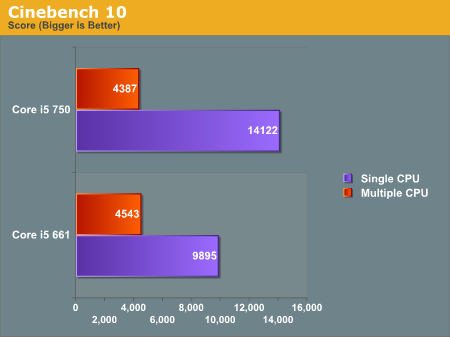The Clarkdale Experiment: Mea Culpa
by Loyd Case on May 4, 2010 1:57 PM ESTNon-Game Performance
Ignoring generic performance benchmarks like Sysmark, I ran a couple of media encoding tests, POV-RAY 2.70 (beta 35a) and Cinebench 10. The idea wasn’t to make any definitive judgment about performance, but just get a feel for how the two CPUs might perform in memory intensive tests.



It’s no big surprise that the Core i5 750 outperforms Clarkdale; these apps are multithreaded, and physical cores will trump virtual cores in this class of application. As you can see, in both POV-RAY and Cinebench, Clarkdale’s single core performance is a little higher than Lynnfield – but the differences are much smaller than the even the 12.5% disparity in Turbo Boost peak clock speeds. It’s possible that the L3 cache size disparities have an impact.
But these systems are gaming systems, so let’s take a look at how they perform with games.










45 Comments
View All Comments
fixxxer0 - Tuesday, May 4, 2010 - link
the table comparing the two systems calls the lynnfield an i7 750.hyvonen - Tuesday, May 4, 2010 - link
The colors in most graphs indicating multi-threaded/single-threaded scores are reversed.numberoneoppa - Tuesday, May 4, 2010 - link
:3Shadowmaster625 - Tuesday, May 4, 2010 - link
Why even use a chip that has built-in graphics if you're not using them? That in itself makes it a waste. But the lynnfield is a waste too for gamers. An overclocked E6300 or phenom X2 550 would make much more sense.hyvonen - Tuesday, May 4, 2010 - link
Similarly, if you're building a HTPC rig, why have an overkill graphics card, especially if the CPU (i5-661) already has an HD-capable IGP in it?Those power numbers are superhigh. My i5-670 based HTPC rig idles at 22W, with load around 85W.
jordanclock - Tuesday, May 4, 2010 - link
The article states that the machine would be used mainly for PC Gaming. I think this fits well within the definition of a HTPC, as a video game console could just as easily be considered part of a home theater set up.DanNeely - Tuesday, May 4, 2010 - link
Because Intel's pushed onchip gfx across its midrange line of CPUs. They don't have a dual core Nehalem chip without integrated GFX. Next year when LGA2011 (sandy bridge) replaces LGA 1366 for high end systems and low end core2 chips are replaced with either lower cost LGA1156 (nehalem) or new LGA1155 (sandy bridge) chips they'll have done so across their entire product line.Hopefully by then the GPU switching technology being deployed in a few laptops will have been added to desktop drivers as well for even greater power savings at idle.
TonyB - Tuesday, May 4, 2010 - link
If I were gulding an HTPC, I’d drop down to a lower priced CPU, and a graphics card with less power draw (and costing less.)CSMR - Tuesday, May 4, 2010 - link
And an HTPC doesn't benefit from a discrete graphics card.Taft12 - Wednesday, May 5, 2010 - link
Indeed a discrete graphics card is a hindrance to an HTPC in terms of power usage and heat generation.